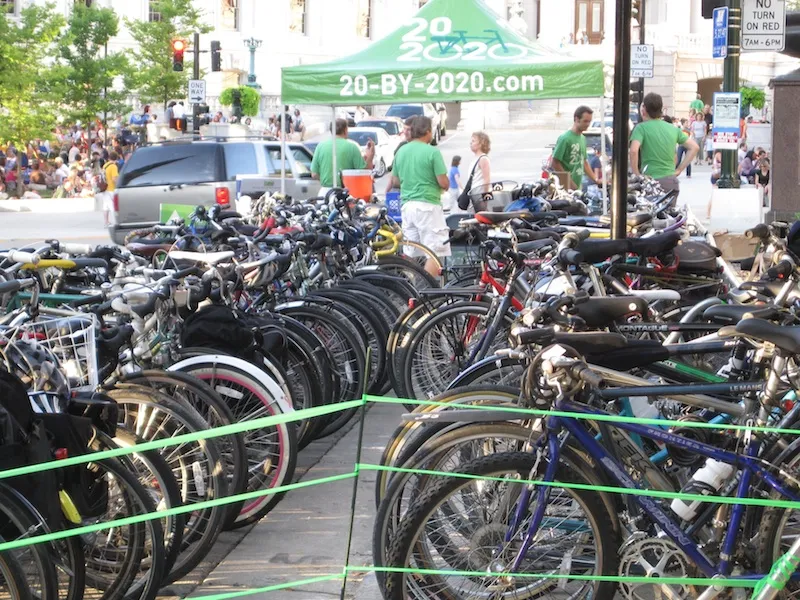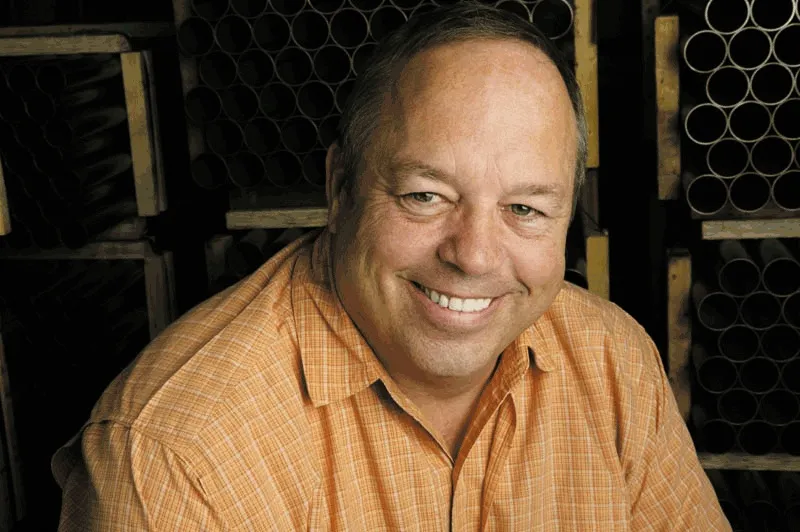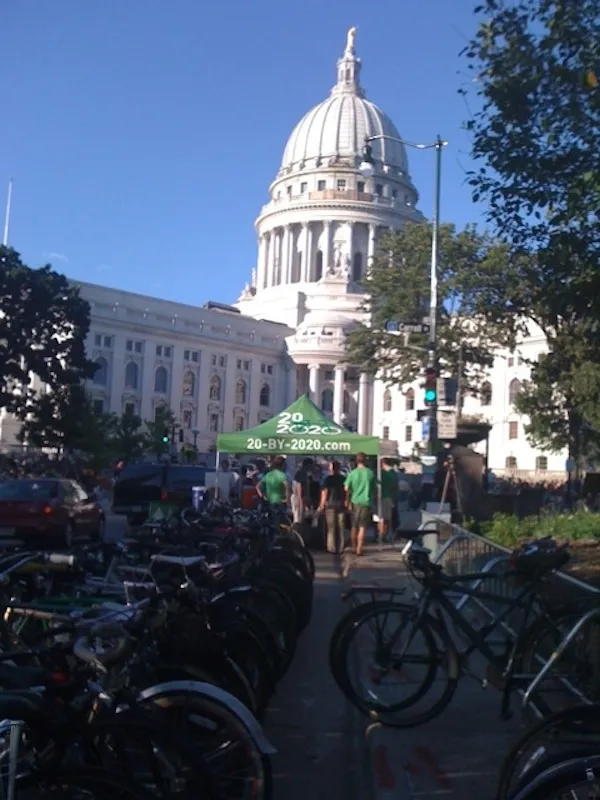20BY2020 began as a trip to study European bicycle commuting infrastructure, which turned into a blog, then an organization and now a movement. Its aim? For 20 percent of residents in Madison, Wisconsin to be making daily trips by bike within 10 years.
The project is the brainchild of Saris co-founder Chris Fortune, who also happens to be vice-chairman of the bicycle advocacy organization Bikes Belong. He funded the European trip which started everything off back in April.
City mayor Dave Cieslewics, his chief of staff, two city engineers, some developers including the county commissioner, a banker and the University of Wisconsin’s vice chancellor of facilities headed to Munster in Germany – voted the most livable city in the world in 2006 — to look for ideas transferable to Madison.
Their the team researched how bicycles are integral to European city life and how to adopt those methods to Madison. After Munster, they travelled on to the Netherlands, where they ended up stranded in Amsterdam for three days due to Iceland’s volcanic eruption.
BikeRadar caught up with Fortune, whose family company Saris – the name combines Chris and his wife Sara’s first names – is among the bike industry’s most socially conscious, to talk about the trip and subsequent 20BY2020 movement, and what you can do to make a similar change in your own city.
How did this trip to Europe come about and what did you do there?
If we were really going to create change we needed to figure out what was the best way to do it. The trip took the people who really have an opportunity to influence change in Madison to Europe to explore what world-class cycling looks like.
The first city we went to was Munster, Germany, which is very similar in size to Madison so it was perfect for us to check it out. We [Madison] have a big university here with 40,000 students; well, there’s a university in Munster that’s very similar in size and we met the staff there.
Every day we travelled we met with the city planners and city engineers, and we took tours of their cities to understand how they’ve integrated cycling into their communities. Munster's mode share [the proportion of residents making daily trips by bike] is over 30 percent.
How did you convince these government and university officials to take this trip with you?
The mayor of Madison clearly understands urbanism and he looks at the bike as being a way to improve the quality of life in Madison. He was instrumental in helping choose who came on the trip.
We sat down, collectively, to decide who was important to bring to make sure that we had buy-in from the developers and the business community to create the change needed to achieve our goals in Madison.
Was 20BY2020 a vision before the trip or is it a product of the trip?
It evolved over time. Originally 20BY2020 was our blog for messaging back to Madison. Through the blog we created a movement and people seemed to really attach themselves to the goal.
The barometer for safe cycling is the number of women on bikes. When we were in Amsterdam we did our own little study and 51 percent of the people riding bikes were women. It’s all about creating a safe environment for people to get around.
This goal of 20 percent mode share by 2020, how achievable is it?
It’s aspirational. With our university being in part of the downtown area, there are areas that already have a 10 percent mode share, but in Madison generally we’re at three percent.
When we came back and looked at things, the mayor’s goal in the Isthmus (the downtown university area) was to obtain 20 percent mode share. In that space we think we can achieve the goal. When you extend further out, it becomes more challenging.
The whole thing is about the journey and how to get there. The mayor has just finalized his budget and he’s included US$50 million for bicycle and pedestrian development over the next five years; that’s $10m per year.
So, since April how has the movement progressed? Along with the mayor’s budget, are there other successes to speak of?
We’ve met quarterly and we’ve just finished another meeting to get the updated plans from the city. We’re doing what we can to help the city deal with issues with [now defunct] railroad corridors and getting access to them. Clearly the challenge is political. Politicians are risk adverse, so you have to create a community of support to get things done.
We have over 1,000 people who've signed our pledge. Our goal is 10,000. Being green is important to people in Madison and they understand that the bike can do a lot, in terms of fitness, combating obesity and other problems that we have here.
What are some of the immediate and more long-term goals of the movement?
The first and most important thing was to have [the city] do a bicycle plan. They’ve committed to do it and they've money set aside. Without a plan you have no direction, so that's the first thing.
The mayor then suggested that the Bicycle Federation of Wisconsin put together a team of community leaders who'll help interface with the city to guide them through the future of the program. For me it’s figuring out how you set the goals and develop the strategies to get there, but then the public have to speak about what they want.
In the end, public opinion is going to drive where we’re going to go. There are a lot of AM [radio] talk stations that are anti-bike and anti-bike-path and other facilities, but I think common sense will prevail. We want to activate the population and get them more physically active, and one way of doing that is to create safe places for people to ride.
What does your day-to-day involvement look like, Chris?
We helped fund the trip, along with Bikes Belong. In doing so, we helped create this 20BY2020 movement. We handed that off to the Bicycle Federation of Wisconsin as a product for them to handle moving forward. We [Saris] were kind of the seed money – we wanted it to germinate and let it grow – and now it’s up to the Bike Fed because it’s their business. The cycling advocates within the community need to take it and drive it forward.
What do you think cyclists outside of Madison can take away from 20BY2020?
When I look at the bicycle industry I think that the bicycle shops need to be the center of the local cycling community. They need to be the center for creating the movement along with the bicycle advocacy groups.
I think you have to show up; you have to be personally engaged and create your own connections within your community in which you can share your vision of what the bicycle can do for your local cities and communities.
For advocates, one way to truly engage local people is to provide bike valet services at key events in the city. We have farmers' markets on Saturday mornings and we do a bike valet there. Every Wednesday night during the summer they do concerts on the square [here in Madison] and we provide bicycle parking where we engage the riders and share our vision and benefits of cycling.

Fortune sees bike valets as a way to encourage bike use and get a message to the riding public
I think if advocates provide bicycle parking at local events they can engage cyclists and make sure they have a shared vision of what the value of the bike can do for their local communities. It will create the political support necessary to drive the agenda.
Did you have a certain moment that inspired you and Saris to head into this – what we can imagine is at times thankless – work for bicycle access?
We always knew it was important and as the company got to the point financially and from a resource standpoint where we were able to do more, we took the opportunity to do more. I don’t know that there was [a specific moment].
It’s an opportunity to create change that’s needed and if we don’t do it from an industry standpoint, who is going to do it? There are a lot of people sitting on the sidelines letting other people do things and we just can’t afford that. We have to be engaged and engage others in the industry to help solve some of the issues that we're faced with.
As a population, many of the health issues we have are created by inactivity, and the bike can solve a lot of these issues. It can’t solve everything, but it can help in a big way. The motivation of knowing the good we’re doing is probably what’s driving us.

